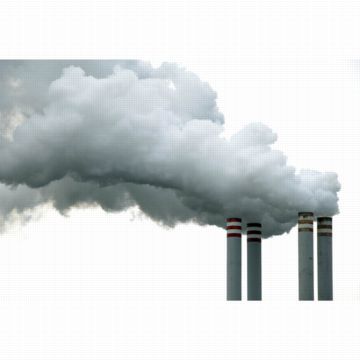Home > Press > Copper catalyst recycles carbon dioxide: Versatile reaction could help greenhouse gas become a more useful synthetic chemical
 |
| Figure 1: Carbon dioxide is a greenhouse gas which accelerates global warming—but it could also become a versatile synthetic chemical. |
Abstract:
RIKEN chemists have developed a catalyst that should allow carbon dioxide to be used as a versatile synthetic chemical.
Copper catalyst recycles carbon dioxide: Versatile reaction could help greenhouse gas become a more useful synthetic chemical
Japan | Posted on October 10th, 2008Carbon dioxide (CO2) is produced whenever fossil fuels are burned (Fig. 1), and it is a powerful greenhouse gas that traps heat in our atmosphere, contributing to global warming. As such, turning the gas into a chemical feedstock, rather than allowing it to escape into the atmosphere, is an extremely appealing idea.
In fact, industry has long used carbon dioxide as a chemical building block—in the manufacture of the painkiller aspirin, for example—but its use is limited by the difficulty of breaking open its strong carbon-oxygen double bonds.
Carbon compounds activated by lithium or magnesium are often needed to attack and incorporate carbon dioxide successfully, but these reagents are extremely reactive and quite hazardous on a large scale.
Chemists have recently developed milder, boron-based alternatives, which require a rhodium catalyst to speed up the reaction. Unfortunately, this catalyst tends to break down particularly sensitive chemical groups in the product.
Zhaomin Hou, of RIKEN's Advanced Science Institute, Wako, along with colleagues Takeshi Ohishi and Masayoshi Nishiura, has now developed a copper catalyst that helps the boron compounds to react with carbon dioxide without destroying sensitive chemical groups.
This makes the reaction particularly useful for building complex molecules containing several different types of chemical group, something that would not be possible with the harsh lithium reagents. "We have tried many different metal compounds, among which the copper catalyst was the best," says Hou.
The team was also able to study exactly how the catalyst works, by isolating key molecules at various intermediate stages of the reaction. They found that the active copper catalyst first displaces the boron group from the starting molecule, forming a new copper-carbon bond. Carbon dioxide then inserts itself into this bond before the copper catalyst is finally removed, leaving behind a carboxylic acid (-CO2H) group1.
Various forms of the boron compounds, known as boronic esters, are commercially available, says Hou. "And they can also be easily prepared in the lab."
Hou adds that their method is also amenable to large-scale, commercial synthesis. "Since CO2 is a renewable carbon resource, exploration of new reactions and catalysts for its efficient use is of great importance," he says. "One of our goals is to find a catalyst that can transform CO2 in exhaust gasses of automobile vehicles or chemical plants into useful materials."
Reference
1. Ohishi, T., Nishiura, M. & Hou, Z. Carboxylation of organoboronic esters catalyzed by N-heterocyclic carbene copper(I) complexes. Angewandte Chemie International Edition 47, 5792-5795 (2008).
The corresponding author for this highlight is based at the RIKEN Organometallic Chemistry Laboratory
####
For more information, please click here
Copyright © Riken
If you have a comment, please Contact us.Issuers of news releases, not 7th Wave, Inc. or Nanotechnology Now, are solely responsible for the accuracy of the content.
| Related Links |
| Related News Press |
News and information
![]() Researchers develop molecular qubits that communicate at telecom frequencies October 3rd, 2025
Researchers develop molecular qubits that communicate at telecom frequencies October 3rd, 2025
![]() Next-generation quantum communication October 3rd, 2025
Next-generation quantum communication October 3rd, 2025
![]() "Nanoreactor" cage uses visible light for catalytic and ultra-selective cross-cycloadditions October 3rd, 2025
"Nanoreactor" cage uses visible light for catalytic and ultra-selective cross-cycloadditions October 3rd, 2025
![]() Researchers tackle the memory bottleneck stalling quantum computing October 3rd, 2025
Researchers tackle the memory bottleneck stalling quantum computing October 3rd, 2025
Chemistry
![]() "Nanoreactor" cage uses visible light for catalytic and ultra-selective cross-cycloadditions October 3rd, 2025
"Nanoreactor" cage uses visible light for catalytic and ultra-selective cross-cycloadditions October 3rd, 2025
![]() Cambridge chemists discover simple way to build bigger molecules – one carbon at a time June 6th, 2025
Cambridge chemists discover simple way to build bigger molecules – one carbon at a time June 6th, 2025
Announcements
![]() Rice membrane extracts lithium from brines with greater speed, less waste October 3rd, 2025
Rice membrane extracts lithium from brines with greater speed, less waste October 3rd, 2025
![]() Researchers develop molecular qubits that communicate at telecom frequencies October 3rd, 2025
Researchers develop molecular qubits that communicate at telecom frequencies October 3rd, 2025
![]() Next-generation quantum communication October 3rd, 2025
Next-generation quantum communication October 3rd, 2025
![]() "Nanoreactor" cage uses visible light for catalytic and ultra-selective cross-cycloadditions October 3rd, 2025
"Nanoreactor" cage uses visible light for catalytic and ultra-selective cross-cycloadditions October 3rd, 2025
Environment
![]() Researchers unveil a groundbreaking clay-based solution to capture carbon dioxide and combat climate change June 6th, 2025
Researchers unveil a groundbreaking clay-based solution to capture carbon dioxide and combat climate change June 6th, 2025
![]() Onion-like nanoparticles found in aircraft exhaust May 14th, 2025
Onion-like nanoparticles found in aircraft exhaust May 14th, 2025
![]() SMART researchers pioneer first-of-its-kind nanosensor for real-time iron detection in plants February 28th, 2025
SMART researchers pioneer first-of-its-kind nanosensor for real-time iron detection in plants February 28th, 2025
|
|
||
|
|
||
| The latest news from around the world, FREE | ||
|
|
||
|
|
||
| Premium Products | ||
|
|
||
|
Only the news you want to read!
Learn More |
||
|
|
||
|
Full-service, expert consulting
Learn More |
||
|
|
||








